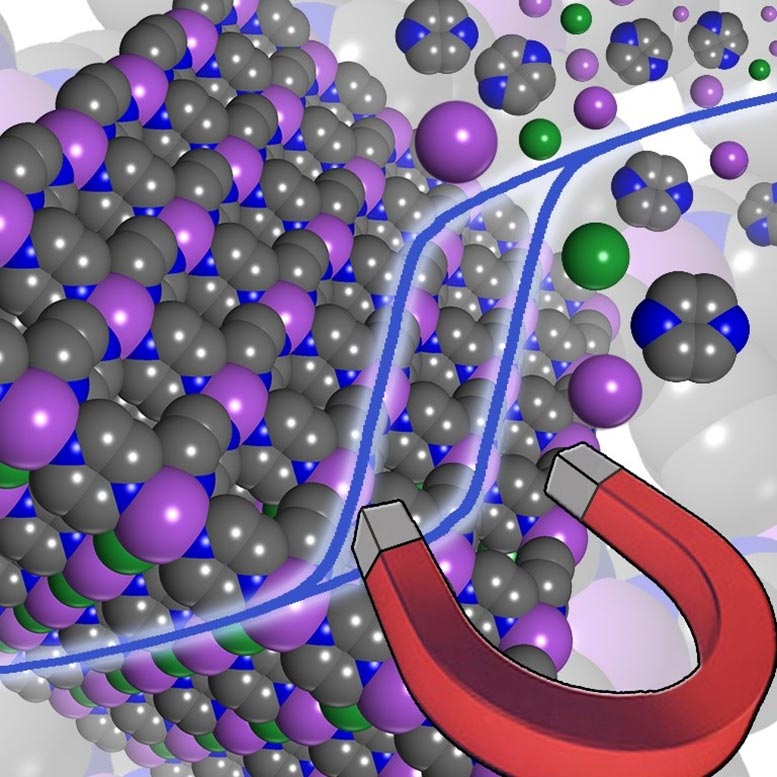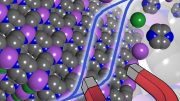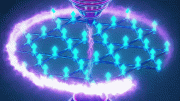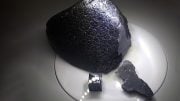
Pictural representation of the molecule-based magnet and its magnetic properties. Credit: Rodolphe Clérac
Magnets are to be found everywhere in our daily lives, whether in satellites, telephones or on fridge doors. However, they are made up of heavy inorganic materials whose component elements are, in some cases, of limited availability.
Now, researchers from the CNRS, the University of Bordeaux, and the ESRF (European Synchrotron Radiation Facility in Grenoble)[1] have developed a new lightweight molecule-based magnet, produced at low temperatures, and exhibiting unprecedented magnetic properties.
This compound, derived from coordination chemistry[2], contains chromium, an abundant metal, and inexpensive organic molecules. This is the first molecule-based magnet that exhibits a ‘memory effect’ (i.e. it is capable of maintaining one of its two magnetic states) up to a temperature of 240 °C. This effect is measured by what is known as a coercive field, which is 25 times higher at room temperature for this novel material than for the most efficient of its molecule-based predecessors. This property therefore compares well with that of certain purely inorganic commercial magnets.
The discovery, published on October 30th in Science, opens up highly promising prospects, which could lead to next-generation magnets complementary to current systems.
Watch videos illustrating the molecule-based magnet’s properties before and after its final synthesis step.
Notes
- The scientists work at the Centre de Recherche Paul Pascal (CNRS/Université de Bordeaux), Institut de Chimie de la Matière Condensée de Bordeaux (CNRS/Université de Bordeaux), Laboratoire Ondes et Matière d’Aquitaine (CNRS/Université de Bordeaux) at the Institut des Sciences Moléculaires (CNRS/Université de Bordeaux/Bordeaux INP), and ESRF – the European Synchrotron Radiation Facility.
- Coordination chemistry focuses on the combination of metals and ligands at the molecular level.
Read Scientists Design New Lightweight Magnets With Outstanding Properties for more on this research.
Reference: “Metal-organic magnets with large coercivity and ordering temperatures up to 242°C” by Panagiota Perlepe, Itziar Oyarzabal, Aaron Mailman, Morgane Yquel, Mikhail Platunov, Iurii Dovgaliuk, Mathieu Rouzières, Philippe Négrier, Denise Mondieig, Elizaveta A. Suturina, Marie-Anne Dourges, Sébastien Bonhommeau, Rebecca A. Musgrave, Kasper S. Pedersen, Dmitry Chernyshov, Fabrice Wilhelm, Andrei Rogalev, Corine Mathonière and Rodolphe Clérac, 30 October 2020, Science.
DOI: 10.1126/science.abb3861









CAN THESE MOLECULE BASED MAGNETS BE USED TO DETRACT ALL CORONAVIRUSES FROM GETTING NEAR THE CELL’S RECEPTORS, BY TRAPPING THE VIRUS & PREVENTING FURTHER MOBILITY? WHEN TRAPPED, EITHER, CAGE THEM OR NEUTRALIZE COVID-19 TO PREVENT IT FROM BINDING TO THE CELL’S ACE-2 RECEPTORS. THIS COULD STOP THE VIRUS REPRODUCTION CYCLE, AT THE SAME TIME PREVENT THE CELL FROM DYING…
IF A MAGNET IS FORMED FROM THE SURROUNDING ELECTRIC FIELD, IS IT POSSIBLE TO OVER-MAGNETIZE COVID-19’S ANTENNAS? DAMAGED ANTENNAS WILL NOT BE ABLE TO BIND TO THE CELL’S RECEPTORS. WHAT OTHER PROPERTIES CAN WE FIND IN THESE MOLECULE BASED MAGNETS TO USE AS TOOLS TO DEFEAT CORONAVIRUS?